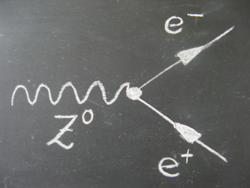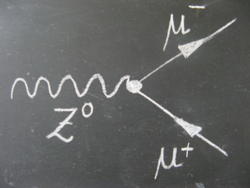More about the Z boson
The exchange/carrier particles mediating weak interactions are the charged W+, W- and the neutral Z. Let's look a bit closer at how the Z particle can decay once it is produced.
Decay of Z bosons
Since Z is neutral the sum of the charges of its decay products must be 0. This is because in nature charge is conserved.
Therefore Z must decay into a particle, antiparticle pair. The 100% probability of Z to decay is divided between groups of particles according to additional conservations laws.
-
In 10% of the Z-decays, charged lepton-antilepton pairs are produced. The three possible charged lepton pair types are electron-positron, muon-antimuon, and tau-antitau pairs. Each pair is approximately equally probable.
- This gives 3 decay possibilities.
-
The Z boson decays in 20% of the cases into a neutrino-antineutrino pair. Our detector is not capable of detecting neutrinos since they almost don't interact with anything (no electric charge). The neutrinos are therefore invisible to us and the only way we can “see” them is when we measure that there is some energy or transverse momentum missing after the collision (since we know that both transverse momentum and energy should be conserved in the collision).
- The neutrino decays gives another 3 possibilities.
- In 70% of Z decays, a quark-antiquark pair is produced. These appear as particle showers called “jets“ in the detector.
-
Quarks have a property we call "colour", and each quark comes in 3 colours.
- Adding up the 6 quark-types (up, down, charm, strange, top, bottom) each with 3 colours results in 18 decay possibilities.
This gives a total of 24 decay possibilities, but only 21 visible. "Luckily" we will only concentrate on two of the easiest detectable decay-modes, the decay into electron-positron or muon-antimuon.
Physicists use Feynman diagrams to visualize particle production and decay. Follow this link to learn about Feynman diagrams. Have a look at the Feynman diagrams of the electron-positron and muon-antimuon decays of the Z.
Z boson measurement
The Z boson has been measured extremely precisely at the earlier particle accelerator at CERN, the LEP (Large Electron-Positron Collider). LEP was actually nicknamed the Z-factory! The Z boson is a necessary part in the jigsaw puzzle, which makes up our theory of elementary particles and their interactions. The Z and the W bosons mediate all phenomena governed by weak interactions. In order to reproduce reality the theory behind weak interactions dictates the way the Z boson (and the W's) should behave. One of the big achievements of the LEP experiments was the precise measurement of all observable Z decays (to charged leptons and to hadrons, which has been used to extract information about Z decay into neutrino-antineutrino). This information has proven that, at current energies, there are exactly 3 types of neutrino species and, thereby, 3 families of leptons and quarks.
This is in agreement with all current observations, and is therefore a highly valuable result, placing the Z boson in theory and in Nature exactly where it needs to be for our world to look like it does.

